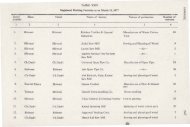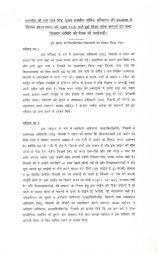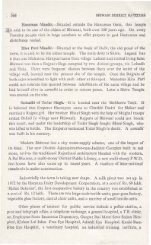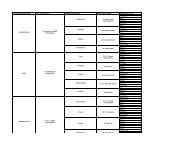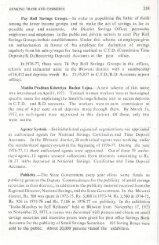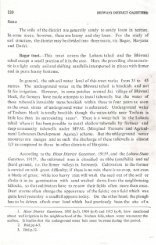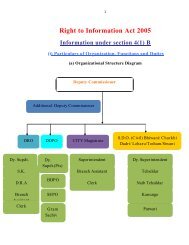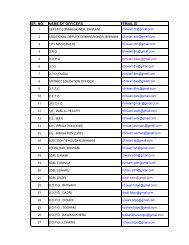chapter - vii - revenue and disaster management department, haryana
chapter - vii - revenue and disaster management department, haryana
chapter - vii - revenue and disaster management department, haryana
Create successful ePaper yourself
Turn your PDF publications into a flip-book with our unique Google optimized e-Paper software.
Mineral wealth ofthe district isnot considerable. Except kankar aJ?d<br />
building <strong>and</strong> masonary stone, resources inminerals <strong>and</strong> metals are of academic<br />
interest only. Iron ore has been reported from Tosham but the studies so far<br />
made, reveal that the reserves are very small<strong>and</strong> uneconomic for exploitation.<br />
Pyrite occurrences have also been reported from Khodana. Malchite stains<br />
which indicate presence ofcopper have been noticed inTosham areal.<br />
The district iswell supplied with kankar deposits. Itisusedfor cement<br />
manufacturing <strong>and</strong> road construction. Soft variety iscrudely burnt for lime<br />
for house construction.<br />
There are a number of building stone <strong>and</strong> masonary stone quarries in<br />
thedistrict. Rocks are quarried for use as building stone <strong>and</strong> also in the<br />
construction of roads, canals bridges, etc. Stone crushing industries are<br />
flourishing inthe district. Road metal isexported not only to the adjoining<br />
districts but also to the Punjab.<br />
Friable quartzites 'occur in the west of Atela Kalan in the Dadri<br />
tahsil. This is crushed to powder <strong>and</strong> used as glass s<strong>and</strong> or for the<br />
manufacture of sodium silicate.<br />
Clay for the manufacture of bricks, earthen pots <strong>and</strong> other allied<br />
purposes isabundent inthe district.<br />
Saltpetre isfound ina large number ofvillagesofBawani Khera, Tosham<br />
<strong>and</strong> Bhiwani blocks. It occurs as thin white encrustations on the surface.<br />
Mostly, itisexported out ofthe State, where itisused infirework industries.<br />
The National Council of Applied Economic Research, New Delhi had<br />
carried out'a Techno-Economic Survey of Haryana <strong>and</strong> published areport in<br />
November 1970. It made some recommendati:ms for development of industry<br />
in backward areas basing them on the suggestions ofthe Wanchoo<br />
Committee. Oneofthe suggestions wasthat growth points should beselect-<br />
,edfor intensive development tohave maximum impact onabackward (region.<br />
Are.as either already having a well-developed infrastructure, orhaving an inherent<br />
development potential weretobepreferred for~electionofgrowth points.<br />
Jt wasalso suggested that the Government should carry out detailed surveys
['}:<br />
194<br />
<strong>and</strong> feasibility studies of the prosp(,(;tive industries <strong>and</strong> make them available<br />
to entrepreneurs.<br />
Soon after, the Industries Department requested the Small Industries<br />
Service Institute, New Delhi to initiate studies for selecting growth centres<br />
:inthe State. The term "growth centre" essentially refers to any area which<br />
has the potential for further expansion, <strong>and</strong> which would ultimately beccme a<br />
centre of attraction for concentrated development. After a detailed survey,<br />
the Institute has sinceidentified Bhiwani as a growth centre for reasons of its<br />
·locational advantage <strong>and</strong> availability of infrastructural facilities like l<strong>and</strong>,<br />
power, skilled workers, banks <strong>and</strong> educational institutions. The survey team<br />
has identified 65 new industries (Table XX of Appendix) for develop-<br />
.ment at Bhiwani. Ofthese, 59 industries are dem<strong>and</strong> based <strong>and</strong> the remaining6<br />
areresource/skill based. These willrequire atotal investment ofRs. 1.50<br />
crores <strong>and</strong> 1250 H.P. of electricity. The space requirements willrange from<br />
101 to 900 square metres. The units will produce goods worth Rs. 4.60<br />
crores <strong>and</strong> provide employment to 1,300persons.<br />
LARGE AND MEDIUM-SCALE INDUSTRIES<br />
Ofthe 8large <strong>and</strong> medium-scale industries l functioning intheBhiwani<br />
district, 7are located at Bhiwani <strong>and</strong> 1at Charkhi Dadri. These are:<br />
1. Technological Institute of Textiles/Bhiwani Cotton Mills, Bhiwani.-<br />
This institute was established at Bhiwani in 1943 under the auspices of the<br />
Birla Education Trust. The object wastoprovide high grade training intextile<br />
technology to meetthe need of the textile industries <strong>and</strong> also to help create<br />
an industrial atmosphere which is necessary to encourage the right type of<br />
training. The Bhiwani Cotton Mills was attached to this institute for<br />
providing practical training in mill working conditions~.<br />
A smallfactory with 12,100 spindles <strong>and</strong>240 looms <strong>and</strong> manufacturing<br />
coarse counts ofyarn, cloth <strong>and</strong> niwar in1938, the Bhiwani Cotton Mills has<br />
now grown into a big factory. It has 33,124spindles <strong>and</strong> 644 looms, <strong>and</strong><br />
manufactures medium <strong>and</strong> fine counts ofcotton yarn <strong>and</strong> cloth <strong>and</strong> synthetic<br />
blended yarn besides terene suiting <strong>and</strong> shirting. Thefactory has kept abreast<br />
with technological developments <strong>and</strong> has installed the latest type ofmachinery<br />
1. Keeran Vegetable Products Ltd., a large-scale unit, was established at Bhiwani in<br />
1972 for the manufacture of vegetable (vanaspati) ghi. It was closed in January 1976.<br />
2. For more details about courses offered <strong>and</strong> training tfacilities provide? at t~
such as Metallic Cards, High Sp~ed Draw Frames, Sixplex, Combers, Ring<br />
Frames with modern High Draft System, Schlafhorst Pirn Winder, Barber<br />
CaIman Spaoler <strong>and</strong> Warpper, Automatic Looms, Calenders, Jiggers Cheese<br />
<strong>and</strong> Beam Dyeing Plant, Mercerising Plant, Singeing, Raising <strong>and</strong> Roller Printing<br />
Mlchin~3, Screen Printing Section, Hot Air Stenter with Heat Setting<br />
arrangements, etc.<br />
The re-generated <strong>and</strong> synthetic fibres such as rayon, nylon, terene,<br />
acrylic, etc., have rapidly taken over leadership from natural fibres' both in<br />
verntility <strong>and</strong> quantitative output on account oftheir excellent performance:<br />
wash <strong>and</strong> Wear characteristics, <strong>and</strong> better h<strong>and</strong>ling <strong>and</strong> draping qualities. In<br />
1963, 1,0~O neWspindles wereinstalled inaseparate building <strong>and</strong> the spinning<br />
ofman-made fibreswasstarted. For the lastfewyears, the millhas also been<br />
mlnufacturing terene suiting <strong>and</strong> shirting that sellunder the br<strong>and</strong> ofT.I.T.<br />
Terene.<br />
Employment <strong>and</strong>production figuresofthemill are shown in Table A<br />
<strong>and</strong> theworking result inTable B below :<br />
Year Employment Production<br />
----- ---~---<br />
(Number) (Rs.in lakhs).<br />
1966 2,483 331<br />
1970-71 2,564 680<br />
1971-72 2,701 770<br />
1972-73 2,901 735<br />
1973-74 3,023 858<br />
1974-75 4,000 937<br />
1975-76 2,919 921<br />
1976·77 3,132 1,181
196(,<br />
1970-71<br />
1971-72<br />
1972-73<br />
1973-74<br />
1974-75<br />
1975-76<br />
1976-77<br />
TABLE B<br />
Bmw ANi DISTRICT GAZETTEER<br />
(Rs. in 1akhs)<br />
Total assets Net sales Wages <strong>and</strong> Gross profit/<br />
salaries loss (-)<br />
------ ------ -----<br />
(Rs.) (Rs.) (Rs.) (Rs.)<br />
91.07 326.63 60.65 29.92<br />
83.55 595.61 86.54 9.84<br />
94.99 708.94 96.85 28.46<br />
103.70 873.76 117.63 62.00<br />
112.11 1,161.74 127.81 137.42<br />
129.95 900.75 123.50 30.00<br />
87.53 974.39 172.78 1.74<br />
80.00 1,171.55 181.05 25.00<br />
(2) Bhiwani Textile Mills, Bhiwani.-Established in 1921,this isanother<br />
composite textile mill. Tobeginwith, itcould notbe worked byitspromoters.<br />
It was purchased by the Punjab Cloth Mills Ltd. in 1938. Its installed<br />
capacity at that time was3,444spindles <strong>and</strong> 145 looms which werenot in<br />
working condition. A lot ofreplirs, adjustments, additions <strong>and</strong> alterations<br />
w~r~ n::cesnry. D~ring 1938to 1961,an addition of 16,652spindles <strong>and</strong> 139<br />
bom; wlS mIde, raising the total installed caplcity to20,090 spindles <strong>and</strong> 284<br />
looms. Despite all these efforts, the factory did not work successfully <strong>and</strong><br />
suffered losses. It W.1S p:1l'chased bythe. Gwalior Rayon SilkManufacturing<br />
(Weaving) Co. Ltd., Birla Gram, Nagda (Madhya Pradesh) inJanuary 1964.<br />
In order to make the millan economically viable unit, an investment ofRs. 50<br />
lakhs was mlde on the modernisation of machinery. The replacement of old<br />
<strong>and</strong> addition of n::wmlchinery cost another 50lakhs. By 1975,the installed<br />
capacity of the millincreased to 20,976 spindles <strong>and</strong> 334looms.<br />
The mill manufactures synthetic blended yarn <strong>and</strong> fabrics. A most<br />
modern <strong>and</strong> up-to-date process house has beenput upatacost ofabout Rs. 60<br />
1akhsfor processing all types offabrics including man-made fibres <strong>and</strong> acrylic<br />
to meetthe present taste <strong>and</strong> dem<strong>and</strong>. The capacity ofthis process house is<br />
10,000metres of synthetic fabrics daily along with fibre <strong>and</strong> yarn dyeing. It<br />
can also process 40,000 metres ofcotton cloth daily. Thus it willcater to the<br />
processing needsofthe textilecomplex beingencouraged atBhiwani, <strong>and</strong> serve
asanUGleusfor thedevelopm~nt ofcotton, silk<strong>and</strong> woollen powerloom units.<br />
Itisclaimed that there isno other suchpro~esshouse inthe whole ofHaryana.<br />
Employment <strong>and</strong> production figures of the millare shown inTable A<br />
<strong>and</strong> the working results in Table B below :<br />
TABLE A<br />
Year Employment Production<br />
(Number)- (Rs.in lakhs)<br />
1966 1,294 123.43<br />
1970 1,342 168.45<br />
1971 1,338 110.52<br />
1972 1,424 143.03<br />
1973 1,408 175.06<br />
1974 1,369 301.60<br />
1975-76 2,246 270.52<br />
1976-77 2,889. 722.59<br />
TABLE B<br />
(Rs. inlakhs)<br />
Year Total assets Net sales Wages <strong>and</strong> _Gross profit!<br />
salaries 10ss(-)<br />
---- ---~ ------ ----------<br />
(Rs.) (Rs.) (Rs.) (Rs.)<br />
1965-66 116.91 119.56 27.29 (-)0.57<br />
1970-71 153.60 183.25 46.77 (:--)29.85<br />
1971-72 217.02 243.97 50.46 (-)16.26<br />
1972-73 263.78 311.78 63.18 (-)16.02<br />
1973-74 254.16 357.51 72.47 2.47<br />
1974-75 231.92· 277.50 76.95 (-)28.73<br />
1975-76 73.56 264.84 85.45 (-)75.19<br />
1976·77 113.46 701.56 99.52 18.14
(3) Hindustan Gum <strong>and</strong> Chemicals Ltd., Bhiwani.~Originally started as<br />
Bhiwani Gum <strong>and</strong> Guar Factory in 1956,this concern had alicensed capacity<br />
for 16,200 tonnes of guar splitsperannum. In 1962,it wasformed into anew<br />
company under the name Hindustan Gum <strong>and</strong> Chemicals Ltd. incollaboration<br />
with Mis Stein Hall <strong>and</strong> Company (Inc. United States ofAmerica). It has an<br />
in,tllld C1Plcity of 12,0» tonnes against the licensed capacity of9,600 tonnes<br />
of refined guar gum.<br />
Guar has been grown in India for centuries <strong>and</strong> before the establishm~ntofthis<br />
factory itwas used m,)stlyascattle-feed. Guar contains mannog1actan<br />
(gum) to the extent of35p.::rcent. After extraction of gum from guar,<br />
theremaining 65p.::rcentisusedas cattle-feed which isknown as guar mealor<br />
guar churi. Guargum isused inmlny industrial applications suchas paper,<br />
t~xtile,p,inting, sizing<strong>and</strong> furnishing,jute, p.::troleumdrilling,pharmaceuticals<br />
fo::>dani p~sticides. For mlnufacturing ead products for most of these<br />
ap;:>licationsthe compmy obtained the requisite know-how <strong>and</strong> the plant from<br />
its American collaborators in 1965. Since then the end products are being<br />
mlnufactured by the company <strong>and</strong> are sold inthe home market.<br />
Ever since its estab1ishm~nt, the company has been making steady<br />
progress in exp)rts of refined guar gum <strong>and</strong> pulverized guar-gum , as well as<br />
guar meal to the Continent <strong>and</strong> U.S.A. Its exports during 1970-71amounted<br />
to more than Rs.2crores, for which thecompany issaid'tohave beenawarded<br />
acertificate of merit for outst<strong>and</strong>ing performance bythe Government ofIndia,<br />
Ministry of Commerce. Its exports during 1976-77 increased to nearly<br />
rupees fivecrores.<br />
Ifproperly processed, the guar meal, can beused for poultry consumption<br />
as a protein aid. The company isplanning to put up a processing unit<br />
to make this product. Bhiwani's guar gum <strong>and</strong> its by-product guar meal<br />
carry the ISI mark <strong>and</strong> are known inthe world market.<br />
Employment, production <strong>and</strong> export figugres of the company are<br />
shown inTable A<strong>and</strong> theworking results inTable Bbelow:<br />
TABLE A<br />
Year Employment Production Export<br />
1 2 3 4<br />
----- ------- ------ ------<br />
(Number) (Rs. inlakhs) (Rs. in lakhs)<br />
1966 60 87.59 52.18<br />
1970 62 240.94 201.12'
·INDUSTRIES ,199<br />
1 2 3 4<br />
(Number) (Rs.in lakhs) (Rs.inlakbs)<br />
1971 58 206.72 136.92 .<br />
1972 55 160.66 49.53<br />
1973 62 162.00 171.48<br />
1974 84 565.00 502.60<br />
'1975-76 92 505.41 354.59<br />
1976-77 100 612.58 498.59<br />
TABLE B<br />
(Rs. inlakhs)<br />
Year Total assets Net sales Wages <strong>and</strong> Gross profit!<br />
salaries loss(-)<br />
(Rs.) (Rs.) (Rs.) (Rs.)<br />
1966 34.53 87.59 1.67 8.46<br />
1970 22.31 240,94 2.50 6.52<br />
1971 20.03 206.72 3.48 5.46<br />
1972 18.13 160.66 3.41 5.64<br />
1973 17.39 161.54 3.10 2.46<br />
1974 58.09 563.71 5.05 10.18<br />
1975-76 24.66 505.41 5.63 12.16<br />
1976-77 27.51 612.66 7.46 48.45<br />
(4) Dalmia Dadri CementLtd., Charkhi Dadri.-The Associated Cement<br />
Comp:lllies had a practical monoply asmanufacturers ofcement inIndia <strong>and</strong><br />
they had been sellingcement at rates fixed at their option. Ram Krishna<br />
Dalmia, arenowned industrialist, took the daring step ofbreaking this monoply<br />
<strong>and</strong> simultaneously installed cement factories at fivedifferent places in India<br />
including Charkhi Dadri. Aplant with 250 tonnes per day production capacitywas<br />
built in 1938 <strong>and</strong> another with 500tonnes per day was added in 1958.<br />
The factory issituated near the railway station of Charkhi Dadri <strong>and</strong> has its<br />
own siding. The factory area includes the company's residential colonr, freer<br />
pjspensar}', primar?, s~hool, pla}'grouqd, etc,
The company 'manufactures portl<strong>and</strong> cement. Kankar is the basic<br />
'raw material which is .found in-agricultura-l fields-. The cement-manufactured<br />
at this factory isconsumed within the State <strong>and</strong> also supplied to the neighbouring<br />
States of Uttar Pradesh, Punjab <strong>and</strong> the Union Territory of Delhi.<br />
Employment <strong>and</strong> production figures of the company are shown in<br />
Table A<strong>and</strong> the working results inTable Bbelow:<br />
TABLE A<br />
Year Employment Production<br />
~--<br />
(Number) (Rs.in la1Ws)<br />
1966 949 214.56<br />
1970 889 214.14<br />
1971 915 197.01<br />
1972 905 176.80<br />
1973 898 200.84<br />
1974 836 268.48<br />
.<br />
(Metric tonnes)<br />
1975 777 132,706.76<br />
1976 756 2,334.22<br />
TABLE B<br />
Year Total assets<br />
(Rs.)<br />
Net sales<br />
(Rs.)<br />
(Rs. inlakhs)<br />
Wages <strong>and</strong> Gross profitl<br />
salaries 10ss(-)<br />
----<br />
(Rs.) (Rs.)<br />
1966 202.38 325.52 29.70 36.39<br />
1970 204.67 345.14 32.35 ~0.09<br />
1971 206.44 327.96 34.25 6.24<br />
1972 207.62 315.27 35.00 (-) 6.77<br />
1973 208.56 337.16 41.55 (-)44.27<br />
1974 200.00 274.00 65.94 (-)77.85<br />
1975 210.66 424.67 46.02 (-)38.28<br />
197() nO.42 72..5~ 42.0~ ?{>4
From the above data itisapparent that except for 1976the company<br />
incurred losses from 1972 to 1975. A number of factors are responsible.<br />
Kankar, which isthe basic raw material <strong>and</strong> was earlier found in the nearby<br />
. agricultural fields, has now to betransported from adistance of about 20to<br />
25 kilometres because the nearby deposits have been exhausted. The compensation<br />
to bepaid to the owners of the fieldshas gone up. Kankar isexcavated<br />
by manual digging <strong>and</strong> the labour charges have also increased considerably.<br />
Previously, octroi on kankar wascharged at concessional rate by<br />
the municipality but now that concession has been withdrawn. Since the<br />
rates for the saleofcement are fixed onall-India basis bythe Government of<br />
India, no particular weightage isgiven to the disadvantageous position of<br />
this factory.<br />
(5) Shri Saraswati Spinning MiIIs~Bhiwani.- This mill wasestablished<br />
in 1969 with 5,000 spindles to produce cotton-waste yarn which wasmuch in<br />
dem<strong>and</strong> at Delhi, Panipat <strong>and</strong> other surrounding areas. Subsequently, the<br />
Central Government gave permission to spin cotton yarn on these spindles.<br />
Since then the millhas progressed <strong>and</strong> exp<strong>and</strong>ed considerably. Asagainst the<br />
sanctioned capacity of 25,000 spindles, it has installed 22,000 spindles.<br />
The mill spins cotton-waste, cotton <strong>and</strong> woollen yarns but it also<br />
proposes to spinalltypes ofsynthetic blended yarn.<br />
Employment <strong>and</strong> production figures of the millare shown inTable A<br />
<strong>and</strong> the working results inTable B below:<br />
Year Employment Production<br />
-----<br />
(Number) (Rs. inlakhs)<br />
1970-71 210 28.00<br />
1971-72 248 46.00<br />
1972-73 259 67.00<br />
1973-74 346 80.00<br />
1974-75 481 120.00<br />
1975-76 250 96.56<br />
1976-77 400 ~8.~9
1970-71<br />
1971-72<br />
1972-73<br />
1973-74<br />
1974-75<br />
1975-76<br />
1976-77<br />
TABLE B<br />
BHIW ANI DISTRICT GAZETIEER<br />
(Rs. in1akhs)<br />
Total assets Net sales Wages <strong>and</strong> Gross<br />
salaries profitjloss( -)<br />
----~ --------<br />
(Rs.) (Rs.) Rs.) Rs.)<br />
28.32 26.72 4.64 3.43<br />
39.89 46.30 5.47 5.96<br />
46.03 61.38 7.24 5.70<br />
69.81 81.18 9.05 7.21<br />
50.00 120.00 13.00 6.00<br />
63.00 87.00 11.00 (-)1.00<br />
63.00 56.00 9.50 (-)1.00<br />
(6) Milk Plant,Bhiwani.- This milk plant isone of the several units of<br />
commercial undertakings ofthe Haryana Dairy Development Corporation<br />
Ltd., Ch<strong>and</strong>igarh. <strong>and</strong> was established in 1972 at Bhiwani, with an<br />
investment of Rs. 69.26 lakhs. The plant has an installed capacity<br />
of 15,000 litres of milk per shift or 35,000 litres of milk per day. The<br />
factory m~nufactures sweetened condensed milk, both full cream <strong>and</strong><br />
skimmed. Itis sold inbulk aswellasinconsumer packs of397grams each.<br />
The condensing equipment installed at the factory was designed <strong>and</strong><br />
fabricated at Faridabad by indigenous enterprise. The five chilling<br />
centres which procure milk are located at Mundhal, Kalanaur, Jui, Loharu<br />
<strong>and</strong> Tosham. Milk isprocured through Milk Supply Cooperative Societies.<br />
Employment <strong>and</strong> production figures of the plant are shown in<br />
Table A <strong>and</strong> working results inTable B below<br />
TABLE A<br />
Year Employment Production<br />
---- -------<br />
1972-73<br />
(Number) (Rs. inlakhs)<br />
1973-74 86 42.91<br />
1975-76 90 96.62<br />
1976-77 77 97.0Q
1972-73<br />
1973-74<br />
1974-75<br />
1975-76<br />
1976-77<br />
203<br />
'tABLE B<br />
(Rs. inlakhs)<br />
Total assets Net sales Wages <strong>and</strong> Gross profit/<br />
salaries 10ss(-)<br />
------- -------~-------<br />
(Rs.) (Rs.) (Rs.) (Rs.)<br />
69.26 1.00 2.16<br />
61.96 45.12 4.20<br />
55.00 80.
(8) Mohta Electro Steel Ltd., Bhiwani.-The unit was established<br />
in August 1975. It manufactures C.R. steel strips.<br />
Employment <strong>and</strong> production figures of the mill are shown in<br />
Table A <strong>and</strong> working results in Table B below<br />
TABLE A<br />
Year Employment Production<br />
(Number) (Rs. in lakhs)<br />
1975-76 183 65.10<br />
TABLE B<br />
(Rs. in lakhs)<br />
Year Total assets Net sales Wages <strong>and</strong> Gross profit!<br />
salaries loss(-)<br />
-----<br />
(Rs.) (Rs.) (Rs.) (Rs.)<br />
1975-76 144.06 54.42 4.71 3.38<br />
SMALL-SCALEINDUSTRIES<br />
On March 31,1977, there were 518 small-scale units in the district.<br />
Of these, 118 manufactured metal <strong>and</strong> engineering goods, 75 chemicals,<br />
68 textiles including synthetic <strong>and</strong> woollen, 46 food articles, 35furniture<br />
<strong>and</strong> wood products, 28brass utenisls, 24 mineral based products, 18 cement<br />
products, 8 optical material, one lime <strong>and</strong> the rest of the 97 miscellaneous<br />
items. For more details see Table XXI of Appendix.<br />
Traditional cottage industries still flourish to some extent in the<br />
district <strong>and</strong> include shoe making, blacksmithy, carpentry leather tanning,<br />
pitloom weaving, ban making, ~c<strong>and</strong>lemaking, stone carving, rosary beads<br />
<strong>and</strong> utensil making by the Thathiar community. There is no speciality<br />
about the products. Even otherwise, these are diminishing in importance<br />
as persons in these industries are switching OVer to more lucrative<br />
occupations. The position at various stages regarding cottage industries<br />
till March 31, 1977isgiven in Table XXII of Appendix.
REGISTERED FACTORIES<br />
On December 31, 1961 only two factories from the Dadri tahsil<br />
stood registered with the Labour Commissioner. These were (i) Dalmia<br />
Dadri Cement Works Ltd. <strong>and</strong> (ii) 'Ishware Industries, both located<br />
at Charkhi Dadri. The former gave employment to 686 workers, while<br />
the latter, which mlnufactured baities, trunks <strong>and</strong> agricultural implements<br />
had an establishment of only 4persons 1 •<br />
Serial Place<br />
number<br />
Name of factory Nature ofwork Number of<br />
workers<br />
Technological Institute of Cloth manu- 1,122<br />
ofTextiles/Bhiwani facturing<br />
Cotton Mills<br />
The Punjab Cloth -do- 2,236<br />
Mills<br />
gKrishana Bobbin Wooden 877<br />
Factory bobbin<br />
B.K. Engineering Dieseloil 8<br />
Works engines<br />
Bhiwani Gum Guar Gum <strong>and</strong> guar 42<br />
Factory manufacturing<br />
The industry -wise data regarding the registered working factories<br />
as on March 31, 1977, <strong>and</strong> the names of these factories are given<br />
respectively inTables XXIII <strong>and</strong> XXIV of Appendix.<br />
INDUSTRIAL LABOUR<br />
Industrial labour inthe district is generally drawn from D.P. <strong>and</strong><br />
R'ljasthan; it migrates on account of shortage of employment aVenues over<br />
there. Moreover, the wage rates prevalent here are higher as compared<br />
to the wage rates being paid in U.P <strong>and</strong> Rajasthan. The general<br />
1. CensusofIndia 1961,District CensusH<strong>and</strong> book, Mahendragarh District, 1966, p.48.<br />
2. Censusof India 1961, District Census H<strong>and</strong> book, Hissar District, 1966, p. 74.
condition <strong>and</strong> st<strong>and</strong>ard of living is quite unsatisfactory due to high prices<br />
of essentialcommodites, non-availability ofhousing facilities, etc. To overcome<br />
this problem, ° the employers are persuaded to construct houses for labour<br />
under the subsidised Industrial Housing Scheme, to open fair price<br />
shops, etc.<br />
Although the industrial institutions <strong>and</strong> schools opened by the<br />
Department of Industries increasingly meet the dem<strong>and</strong> of skilled labourers<br />
<strong>and</strong> help inthe development of industries, yet these do not meet the full<br />
requirements. More skilled h<strong>and</strong>s are needed.<br />
Industrial labour inthe district has to go without work many times<br />
due to shortage of electricity <strong>and</strong> itis compensated by wayof payment of<br />
lay-off compensation inaccordance with the provision of the Industrial<br />
Disputes Act.<br />
The wage rates paid to industrial labour are either fixed under the<br />
Minimum Wages Act, 1948, or under awards <strong>and</strong> settlements. Mostly<br />
there are textile industries inthe district inwhich the wage structure of an<br />
unskilled worker ranges from Rs. 171to Rs. 275 per mensem <strong>and</strong> that of a<br />
skilled worker from Rs. 190 to Rs. 350.<br />
The development of industrial cooperatives is essential for democratic<br />
development ofindustries speciallyinthe cottage <strong>and</strong> small-scale sectors.<br />
Stress is, therefore, laid onthe development ofindustries through cooperatives.<br />
The industrial cooperatives ensure that decentralisation of industry<br />
is accompanied by proper improvement of techniques of production,<br />
procurement of raw material <strong>and</strong> marketing of finished goods.<br />
The cooperative movement inthe district has been finding itsplace<br />
inthe industrial sphere also. The development of industrial cooperatives<br />
is looked after by the Assistant R':lgistrar, Coop~rative Societies, Bhiwani,<br />
who is assisted by 2 Industrial Inspectors <strong>and</strong> 7 Sub-Inspectors. The<br />
activities of the Cooperative Department are confineod to cottage <strong>and</strong><br />
small-scale industries.
INDUSTRIES 207<br />
The following table indicates the number of industrial cooperative<br />
societies that have existed since 1973-'74:<br />
Serial Name of Number of societies (year ending June 30)<br />
Nnmber industry' --_._----------------<br />
1973 1974 1975 1976<br />
-74 -75 -76 -77<br />
1. H<strong>and</strong>loom weav- 34 42 43 41<br />
ing<br />
2. Small Scale<br />
Industries<br />
(a) Engineering goods 28 34 34 32<br />
(b) Wood works 21 21 21 19<br />
(c) Miscellaneous 89 89 86 79<br />
3. Khadi <strong>and</strong><br />
villageIndustries<br />
(a) Non-edible 19 21 21 21<br />
oils<strong>and</strong><br />
soap<br />
(b) Pottery 2 2 2 2<br />
(c) Gur <strong>and</strong> 16 16 16 15<br />
kh<strong>and</strong>sari<br />
(d) Ghani oil 4 4 3 3<br />
(e) Cobblers 48 48 48 41<br />
(f) Leather tanning 8 8 8 7<br />
<strong>and</strong> flaying<br />
of skins<br />
(g) Others 9 10 10 10
Th~value of the goods produced <strong>and</strong> the loans <strong>and</strong> subsidies advanced<br />
to the industrial cooperative societiesare givenbelow :<br />
GENERAL<br />
Year .Valueof Loans Subsidieg<br />
(ending goods produeed . advanced advanced<br />
June 30)<br />
------ ------- ---- -----<br />
(Rs. (Rs.) (Rs.)<br />
1973-74 40,41,694 8,25,663 20,435<br />
1974-75 31,84,000 10,30,000 21,765<br />
1975-76 35,65,000 16,24,000 57,850<br />
1976-77 45,23,000 20,49,000 4,H{<br />
In addition to the number of incentives <strong>and</strong> facilities offered to<br />
attract entrepreneurs to establish industries inthe district, Bhiwani is being<br />
linked with Rohtak through abroad gauge railway line.<br />
A branch of the Small Industries Service Institute, New Delhi, was<br />
opened at Bhiwani in July 1975.It has a workshop with facilities ingeneral<br />
engineering, tool room<strong>and</strong>beat treatment. Machinery worth about Rs.lOlakhs<br />
has already been received. This branch is providing technical know-how to<br />
the industrialists.<br />
A new unit inthe large-scale sector for the manufacture ofprecision<br />
steel tubes with acapital investment of Rs. 1.5crores iscoming upat Bhiwnai<br />
besides a dal mill in the cooperative sector with an investment of about<br />
Rs.50 lakhs.
The money-lender played an important part in the financing of<br />
agriculture inthe villages. He stillenjoyspatronage, though sinceIndpendence<br />
there has been a ·great organized <strong>and</strong> systematic push to diver'sify the<br />
sources that provide credit to farmers, traders, industrialists <strong>and</strong><br />
others engaged in the economic activity. There are now not only<br />
local money-lenders but also cooperative credit societies, banks, jointstock<br />
<strong>and</strong> financial corporations established or encouraged by Government.<br />
Their endeavour is also to mobilize savings. The State also plays an important,<br />
even predominant, role inthe financial sphere by floating loans,<br />
promoting small savings, financing development plans <strong>and</strong> helping<br />
industries.<br />
During the British period the agriculturist's need for money was met<br />
mostly from money-lenders <strong>and</strong> banks were hardly used at all. Some effort<br />
at cooperative credit had been made but there were few'signs of thisin the<br />
Bhiwani district. The indigenous money-lender or banker received deposits,<br />
dealt in hundis, <strong>and</strong> also financed trade <strong>and</strong> industry against the security<br />
of goods. The loans advanoed were both for productive <strong>and</strong> unproductive<br />
purposes. Much of this business depended on personal security, <strong>and</strong> a long<br />
acquaintance through generations contact of the families concerned.<br />
Rates of interest varied, therefore, not "only with the kind of business involved,<br />
but also the character of the borrower <strong>and</strong> the nature of his need.<br />
Many of the. money-lenders were themselves traders, who sold their goods<br />
on credit charging a higher rate, or advanced money on the assurance that<br />
the borrower's produce, agricultural particularly, or the artisan's wares be<br />
offered to them often allowing for exorbitant interest.<br />
Another category of indigenous bankers comprised sharaffs <strong>and</strong> gold.<br />
smiths. They would provide loans on the mortgage of gold ornaments, <strong>and</strong><br />
met needs p~rticularly connected with social events, such as birth, marriage,<br />
illness <strong>and</strong> the like. Interest rates tended to be eccentric, determined by<br />
personal equations, <strong>and</strong> onthe whole were high, particularly in cases of<br />
distress, orwhere the borrower had to postpone repayment.
It is not correct, however, to dismiss themoney-lender's role as wholly<br />
nefarious. He did meet real need, the system was remarkably elastic in<br />
determining security, <strong>and</strong> the crux of the problem was toprovide an<br />
effective alternative to borrowers. Today also, after years of effort at<br />
establishing alternative sources of credit, we are still faced with<br />
the broblem of sound judgment, in individual cases, of determining what<br />
isadequate security <strong>and</strong> a sound loan.<br />
For unproductive loans, even today, people in the village are<br />
overwhelmingly dependent on indigenous <strong>and</strong> personal borrowing.<br />
Possibly no lending or cooperative system will be able to meet needs<br />
arising from distress like illness, or social custom <strong>and</strong> pressure like<br />
marriage. Here the solution lies in a long term habit of saving,<br />
so that the rough can be taken by the smooth, <strong>and</strong> the individual's<br />
general credit is such that he can raise money, without submitting<br />
to extortion, should need compel. The setting up of cooperatives <strong>and</strong> other<br />
agencies has certainly made its 'mark <strong>and</strong> has had its effect in the realm<br />
of strictly productive borrowing.<br />
Inthe British Punjab, <strong>and</strong> particularly under the inspiration <strong>and</strong><br />
guidance of Chhotu Ram, who was Revenue as also~Development Minister<br />
before Independence, attempts had been made not only to provide cooperative<br />
credit but also to protect the agriculturists <strong>and</strong> weaker sections from<br />
exploitation by money-lenders. The Usurious Loans Act, 1919, the Punjab<br />
Regulation of Accounts Act, 1930, the Punjab Relief of Indebtedness<br />
Act,1934, the Punjab Debtors' Protection Act, 1936 <strong>and</strong> the Punjab<br />
Registration of Money Lenders' Act, 1938were designed to achieve this. It is<br />
doubtful if these measures stopped the more harmful adverse effects ofthe<br />
system. They certainly diverted adverse practices tocl<strong>and</strong>estine forms, <strong>and</strong><br />
the fact t,hat in 1974-75 there were only 2 licensed money-lenders in the<br />
Bhiwani district may not be an entirely correct indication of the extent to<br />
which money-lending is now an insignificant source of ctedit.<br />
In addition to coop~rative agencies, institutions like the Khadi <strong>and</strong><br />
V.ilIageIndustries Commission provide credit facilities in rural areas. The<br />
Government also advances taccavi loans under the L<strong>and</strong> Improvement<br />
Loans Act, 1883 <strong>and</strong> the Agriculturists Loans Act, 1884. These<br />
loans are given for seed, cattle, agricultural implements <strong>and</strong> also under<br />
various schemes, e.g. Grow More Food <strong>and</strong> (2ommunity Projects. The<br />
foJlowin~ table shows the taccavi loans ~pvanced ~l1dthe number of person~
i972-73<br />
1973-74<br />
1974-75<br />
1915-76<br />
1976-77<br />
~accavi loans Persons<br />
advanced benefited<br />
~----<br />
(Rs.) (Number)<br />
30;19,290 30,645<br />
2;02,500 2,521<br />
78,21,000 23,462<br />
41190,000 25,058<br />
17,20,000 5,126<br />
Inthe industrial sector, loans are advanced under the Punjab State<br />
Aid to In:lustries Act, 1935. The loans are also advanced to industrialists<br />
bythe Rtryana Financial Corporation, Ch<strong>and</strong>igarh, which came into being<br />
on April 1,1967. It has a paid-up capital of Rs. 1 crore. The loans<br />
disb'lrsed under the State Aid to Industries Act <strong>and</strong> by the Financial<br />
C:>rporation inthe Bhiwani district have been detailed in the Chapter<br />
on 'Industries'.<br />
The progress made by cooperative institutions in the district has<br />
been impressive; they compete with the commercial banks in mobilising<br />
savings <strong>and</strong> also providing credit especially to the agricultural sector.<br />
On June 30, 1973, there were 500 primary agticultural cooperative<br />
credit service societies <strong>and</strong> 60 non-agricultural credit societies. Theyprovided<br />
facilities for short term <strong>and</strong> m~dium term credit for fertilizers, improved<br />
seeds, im21ell1~nts,m:trketing, storage <strong>and</strong> the extension of advanced agricultural<br />
techniques. The non-agricultural cooperative societies comprise mostly<br />
employees credit societies catering to the requirements of penons outside<br />
agriculture. The following statement gives an idea of the scope of<br />
cooperatives:~
(Rs. in lakhs)<br />
t-,)-.<br />
Particulars Agricultural credit/service societies Non-agricultural credit societies t-,,). -<br />
June June June June June June June June June June<br />
1973 1974 1975 1976 1977 1973 1974 1975 1976 1977<br />
1. Societtes (number) 500 500 493 271 256\ 57 58 60 51 38<br />
2. Membership (number) 67,170 69,170 65,454 65,708 75,317 2.084 2,276 2,564 2,391 2,264<br />
3. Working capital (Rs.) 209.81 209.81 296.79 343.25 445.79 3.36 3.93 4.86 5.98 5.69<br />
4. Deposits (Rs.) 3.73 5.23 4.49 4.35 5.72 0.15 1.04 0.24 0.34 0.31<br />
5. Loans advanced during<br />
the year (Rs.) 122.33 111.40 195.20 196.69 318.57 0.29 0.21 5.09 3.60 0.96<br />
1. The number of societies decreased due to amaJ~ama tion of weak societies into more viable units.
The Bhiwani Central Cooperative Bank Limited, started functioning<br />
in April 1973. It concentrates largely on'rural objectives <strong>and</strong> thus·opened<br />
a number of branches in the rural areas, viz. twoat Bhiwani <strong>and</strong> one<br />
each at Jui, Loharu, Tosham, Siwani, Bawani Khera, Mundhal, Charkhi<br />
Dadri, Baund Kalan, Badhara, Satnali<strong>and</strong> Bahl. The bank issues short <strong>and</strong><br />
medium term loans to individual members, through cooperative societies, <strong>and</strong><br />
provides financial accommodation to the affiliated cooperative societies for<br />
seasonal agricultural operations <strong>and</strong> the marketing of crops. Relevant information,<br />
pertaining to this bank isgiven below :<br />
Position as on the 30th June<br />
(Rs. inlakhs)<br />
------~~<br />
1973 1974 1975 1976 1977<br />
-~- ----<br />
(Rs.) (Rs.) (Rs.) (Rs.) (Rs.)J<br />
1. Share capital 36.54 44.74 50.00 50.57 55.97<br />
2. Working capital 227.67 311.70 361.31 414.55 487.59<br />
3. Deposits 32.29 123.16 101.15 190.41 217:08<br />
4. Loans advanced<br />
(i) Short term agricultural<br />
25.47 102.78 106.44 184.91 330.34<br />
(ii) Medium term agricultural<br />
68.62 89.26 21.48 23.10<br />
(iii) Medium/short term<br />
milk supply 19.61 23.60<br />
(iv) Industrial societies 0.41 2.41 12.62 7.25 4.29<br />
(v) Marketing<br />
societies 37.30 130.66 82.92 87.63<br />
(vi) Primary L<strong>and</strong><br />
Development Bank 2.74<br />
(<strong>vii</strong>) Non-agricultural<br />
purpose 0.16 2.56 3.22 3.29
Cooperative banking isorganized asa federal structure. The primary<br />
cooperative societies constitute the foundation of the system. The working<br />
capital ofthe cooperative bank is uerived mostly from the share capital<br />
contributed bythe primary cooperative societies <strong>and</strong> their deposits. The<br />
cooperative bank inturn arranges financesto meet the requirements of the<br />
members of the coop~rative credit societies. The <strong>management</strong> of the<br />
cooperative bank consists of elected representatives of the cooperative<br />
societies.<br />
PRIMARYLANDDEVELOPMENT BANKS<br />
There are two Primlry V:llldD~velopment B::lllks,one at Bhiwani <strong>and</strong><br />
the other at Cftarkhi Dldri. These blnks were established in 1968 <strong>and</strong> 1970<br />
respectively toprovide long term credit facilities forthepurchase of tractors,<br />
installation oftubewells, improvement of l<strong>and</strong>, levellingof l<strong>and</strong> <strong>and</strong> for the<br />
payment ofold debts. The security for theseloans is immovable property.<br />
Suchfacilities are not provided to frarmers by other cooperative credit<br />
institutions.<br />
The follewing statement shows the working of these two bankis during<br />
1973 to 1977 :-<br />
(Year ending hae)<br />
1973 1974 1975 1976 1977<br />
---- ~- ----<br />
I. Membership (Number) 3,835 4,979 6,457 6,221 6,830<br />
2. Share capital (Rs. in<br />
lakhs) 14.63 18.26 16.49 20.23 28.65<br />
3. Loans advanced (Rs.<br />
inlakhs) 55.47 44.79 65.77 71.30 93.10<br />
4. Loans outst<strong>and</strong>ing (Rs.<br />
inlakhs)<br />
JOINT·STOCKBANKS<br />
133.43 163.53 223.79 263.68 311.75<br />
Prior toIndependence (1947), there wasonlyonejoint-stock bank inthe'<br />
area now comprising the Bhiwani district. The Punjab National Bank had<br />
established a branch atBhiwani in1945.Till 1960 there was nominal expansion<br />
of blnk:in~ facilities. Toe State Bln1cofPatiala op~ned a branch office<br />
at Charkhi Dldri in 195) ani at B:liw~ni in 196'). Commercial banking<br />
exp<strong>and</strong>ed rapidly after 1966. At present (1976), there are eleven banks,<br />
each withbranch offices atvarious places inthedistrict. These banks carry OIle<br />
norrn'l.1banking activities induding deposits, remittances <strong>and</strong> advances against<br />
Government securities aftd otaer ioods. Ail GovernmeJit transactions are
h<strong>and</strong>led by the State Bank of India as the local agent of the Reserve<br />
Bank ofIndia. Thejoint-stock banks, let:ation oftheir branches<strong>and</strong> year of<br />
their opening inthe district are shown below:<br />
Joint-stock banks Location Year of<br />
opening<br />
United Commercial Bank<br />
IndIan Overseas Bank<br />
The Oriental Bank of<br />
Commerce<br />
Bank ofIndia<br />
Lakshmi Commercial<br />
Bank Ltd.<br />
Jndlan Bank<br />
(i) Bhiwani<br />
(ii) Siwani<br />
(i) Bhiwani<br />
(ii) Charkhi Dadri<br />
(iiO Satnali<br />
(iv) Jui<br />
(0 Bhiwani<br />
(ii) Jhuju Kalan<br />
(iii) Mundhal<br />
(iv) Tosham<br />
(i) Bbiwani<br />
(ii) Charkhi Dadri<br />
(iii) Loharu<br />
(iv) Baund Kalan<br />
(v) Bahl<br />
(vi) Chang<br />
(<strong>vii</strong>) Badhara<br />
(i) Bhiwani<br />
(ii) Bawani Khera<br />
Bhiwani<br />
Bhiwani<br />
(i) Bhiwani<br />
(ii) Charkhi Dadri<br />
Bhiwani<br />
'Bhiwani<br />
13hiwani<br />
1971<br />
1970<br />
1960<br />
1949<br />
1972<br />
1971<br />
1968<br />
1972<br />
1970<br />
.1970<br />
1945<br />
1969<br />
1970<br />
1972<br />
1973<br />
1974<br />
1974<br />
1970<br />
1973<br />
1969<br />
1972<br />
1972<br />
1974<br />
1975<br />
1976<br />
197§
The following table showsthe direction inwhich thecommercial banks<br />
financing goes :-<br />
(As on the last Friday of December 1975)<br />
Number of<br />
accounts<br />
(Rs. inthous<strong>and</strong>s)<br />
Amount Percentage<br />
to total<br />
an:ount<br />
(Rs)<br />
Agriculture <strong>and</strong> allied activities 657 7,338 15.2<br />
Industry 389 28,325 58.9<br />
Trade 332 7,825 16.3<br />
Others 1,155 4,608 9.6<br />
Total: 2,533 48,096 100.0<br />
REGIONALRURALBANK, BHIWANI<br />
A new <strong>chapter</strong> was opened in Bhiwani's banking history with the<br />
establishing of a regional rural bank which is one of the first five of these<br />
started inthe country. Sponsored by the Punjab National Bank, this bank<br />
was started at Bhiwani on October 2, 1975, <strong>and</strong> loans worth Rs. 1.22lakhs<br />
were advanced to 74 persons onthe first day. This bank eoncentrates<br />
on credit to the rural population. The bank has a number of schemes for<br />
giving loans <strong>and</strong> advances to small' farmers, agricultural labourers, rural<br />
artisans, small entrepreneurs <strong>and</strong> people with limited means in trade.<br />
InDecember 1976,there were20branches ofthis bank at various places, viz.<br />
Ateli, Bhiwani, Bapora, Bawani Khera, Baund. Kalan, Chirya, Dhigwa,<br />
Dhanana, ~mlota,Isarwa1,Jamalpur, Jhojju kalan, Kairu, Kadma, Ranila,<br />
Sanwar, Satnali, Talwani Rukka, Siwani <strong>and</strong> Tosham.<br />
OnDecember 31,1976,the deposits <strong>and</strong> advances of this bank Wereas<br />
under:<br />
(Rs.)<br />
1,40,799<br />
24,43,647<br />
(Rs.)<br />
1,40,799
Mter the nationalization oflife insurance in 1956, the Life ItisuranclJ<br />
Corporation ofIndia p.as b~come the sole agency for this business.<br />
Inthe Bhiwani district onlytwo companies, i.e. NewIndia Assurance<br />
Company <strong>and</strong> Oriental Fire<strong>and</strong> General Insurance Company, have their agents<br />
whowork for motor accidents <strong>and</strong> general insurance business. Mter the<br />
nationalization of general insurance in 1972,company names do not count<br />
for differences asthe policy is centralized.<br />
The Bhiwani district is under the jurisdiction of the Ch<strong>and</strong>igarh<br />
Divisional Office. The branch office at Bhiwani covers the entire district.<br />
The number of agents convassing life<strong>and</strong> general insurance business inthe<br />
district was 105in 1972-73. During 1972-73,2,268 policies, involving an<br />
amount of Rs. 2.2 crores, were issued. Inthe years 1973-74 <strong>and</strong> 1974-75,<br />
2,171 <strong>and</strong> 2,289 life insurance policies were issued. Similarly the genreral<br />
insurance companies issued 2,183<strong>and</strong> 2,340 policies <strong>and</strong> collected Rs. 215<br />
1akhs <strong>and</strong> 218 lakhs on them during 1973-74 <strong>and</strong> 1974-75. The business<br />
secured by the Life Insurance Corporation <strong>and</strong> the general insurance<br />
companies inthe district during 1972-73to 1974-75isgivenbelow :<br />
Year Life Insurance • General Insurance<br />
1972-73<br />
1973-74<br />
1974-75<br />
Number of Sum assured Number of Premium<br />
policies policies income<br />
------ ------ ----------<br />
Rs. Rs.<br />
2,268 2,22,33,000<br />
2,171 2,15,18,000 2,183 2,15,54,500<br />
2,289 2,15,87,750 2,340 2,18,12,000<br />
The people ofthe district are generally not insurance minded incom·<br />
parison to the towns <strong>and</strong> cities ofother districts. Nevertheless, there were<br />
about 1,000women holding life insurance policies in1972-73. The main<br />
section of the society which is sympathetic to insurance consists of Vaishs,<br />
Jains <strong>and</strong> Punjabis. Business <strong>and</strong> service class are also so inclined.<br />
The net-work ofpost officesinthe district mobilizes small savings_in<br />
rural as well urban areas. Banking facilities are virtually extended toeverypody's<br />
door step throu$h Post Office SavingsBank;. Tb,ereare 34 sub,pO'"l
offices <strong>and</strong> 188 branch post offices besides the head post office. The<br />
following table gives the number of savings bank accounts <strong>and</strong> the total<br />
" . "<br />
amount invested during ~972-73 to 1976-77 .-<br />
19.72-73<br />
(from 1/73<br />
to 3/73)<br />
1973-74<br />
1974-75<br />
1975-76<br />
1976-77<br />
Savings bank<br />
accounts<br />
opened<br />
(Number)<br />
179<br />
4,015<br />
2,612<br />
3,332<br />
4,741<br />
Progressive<br />
number of<br />
savings bank<br />
accounts<br />
(Number)<br />
179<br />
4,194<br />
6,806<br />
10,138<br />
14,379<br />
Deposits<br />
during the<br />
year<br />
(Rs.)<br />
182.99<br />
417.18<br />
277.60<br />
106.92<br />
127.55<br />
(Rs. in lakhs)<br />
Progressivt?<br />
total<br />
(Rs.)<br />
182.99<br />
600.17<br />
877.77<br />
984.69·<br />
1,112.24<br />
A Postal Coordinating Committee has been constituted under the<br />
chairmanship ofthe Deputy Commissioner, Bhiwani, to hold conference with<br />
the Superi~tende~t of Post Offices on postal matters. The committee<br />
examines cases of delay in post offices <strong>and</strong> solves difficulties in regard<br />
to Pay Roll Savings Groups, etc. It considers postal arrangement!>during<br />
special collection drives/ campaigns, the training of Branch Post Masters<br />
<strong>and</strong> Counter Clerks, <strong>and</strong> the postal complaints ofdepositors, authorised agents<br />
<strong>and</strong> rem~dial measures for acceptance of deposits inSmall Savings Secllrities.<br />
For thepromotion ofsmall savi~gs,the National Savings' Organization,<br />
has posted a' District Savings Officer, at Bhiwani. 1 Some of the Small<br />
Savings Schemes are discussed below :<br />
SchoolSavingsBank(Sanchayika) Scheme.- This scheme wasintroduced'<br />
in 1972-73 in Government Higher Secondary School, Charkhi Dadri only.<br />
Up t61973-74, 776students had joined the Sanchayika Scheme<strong>and</strong> deposited.<br />
Rs. 1,861. This scheme was further introduced in 15more schools in 1973"<br />
74<strong>and</strong> 1,463students deposited Rs. 8,331. ByMarch 1977,this scheme wa&<br />
functioning in 105 schools with a membership of 30,124 <strong>and</strong> collection&<br />
amounting to Rs. 1,35,957.



